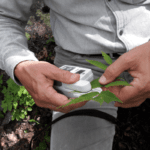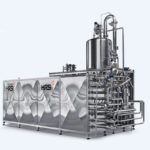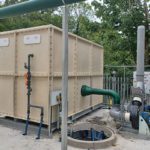A mixture of trees purifies urban air best, reports Swedish study
Conifers are generally better than broadleaved trees at purifying air from pollutants. But deciduous tree may be better at capturing particle-bound pollution. A new...
Cheap charcoal air filters substantially improve in-vehicle air quality
A cheap charcoal air filter can reduce nitrogen dioxide (NO2) inside vehicles by as much as 90%, compared to levels outside the vehicle, according...
Wastewater sector emits nearly twice as much methane as previously thought
Municipal wastewater treatment plants emit nearly double the amount of methane into the atmosphere than scientists previously believed, according to new research from Princeton...
Novel air filter captures wide variety of pollutants
An air filter made out of corn protein instead of petroleum products can concurrently capture small particulates as well as toxic chemicals like formaldehyde...
Prioritise tackling toxic emissions from tyres, urge experts
A new briefing paper from Imperial College London attempts a deep dive on the pollution produced by the particles sloughed off from vehicle tyres....
Does agricultural erosion create a carbon sink or source?
A new study claims to settle a long-standing debate
Over the last decade, researchers have sounded the alarm on soil erosion being the biggest threat...
UK substantially underestimates its methane emissions from oil and gas production – and many...
A newer, more accurate method for calculating methane emissions from offshore oil and gas production suggests that the United Kingdom severely underestimates its greenhouse...
Some local authorities pushing ahead on integrating clean air and Net Zero
A new report argues that Birmingham, Camden, Hertfordshire, Leeds and Nottingham are leading the way in integrating climate and clean air policies but says...
Net zero innovators receive £24 million cash boost from UK government
Next generation energy innovators will receive a £24 million cash boost to develop “new technologies that will decarbonise UK industry, build home-grown energy supplies...
Firm receives InnovateUK funding to enhance vessel performance monitoring technology
Vessel monitoring and control solutions provider, Reygar, has won InnovateUK funding to develop a range of new features for its BareFLEET product in collaboration...
Reappraising assumptions about ozone in European cities
Ozone levels near the surface in urban environments are lower than expected, in the results of an Austrian research group
The 40-meter-high monitoring tower of...
Study flags night-time air pollution in China as potential health threat
China is a night-time ‘hot-spot’ for the production of nitrate radicals (PNO3) that could have a major impact on health-threatening ozone and fine particulates...
Long-term regulatory and policy changes needed to avoid stalls to business decarbonisation
A new report from energy consultancy Cornwall Insight has set out a range of regulation and policy changes the government could examine if it...
Smart technology enables odour mitigation at Paris WtE plant
A waste to energy (WtE) plant in northern Paris, known as the ‘L'étoile Verte’ or ‘Green Star’ waste recovery facility, which was originally built...
Longer-term landmarks needed, concludes the Net Zero review
An independent review of the UK’s current progress and plans in relation to achieving net zero – titled “Mission Zero” - was published on...
Decarbonising local roads: Seven new programmes to start in 2023
A government-funded initiative aiming to accelerate innovation in the roads sector announced funding awards for several new projects on 25 January.
The winning bidders who...
Sponsored Content: Reducing your carbon footprint with heat exchangers
Matt Hale, International Sales & Marketing Director, HRS Heat Exchangers, writes: The biggest efficiency benefits of heat exchangers come about when they facilitate the reuse of as much thermal energy from a process (such as heating, cooling, pasteurisation, evaporation, etc.) as possible.
Sponsored Content: Proprietary tech for affordable clean air
Anua Clean Air UK writes: We are a specialist in the field of biological air and biogas treatment, an established leader in the fields of high performance, low-cost odour and solvent emission abatement primarily based on our proprietary biofiltration and bio-scrubbing technologies.
Particle profiling
A new study has found high concentrations of small particles in the air in the Copenhagen Metro.
SEPA issues first variable penalty
A landfill site in Glasgow has been served with a civil penalty of £6,200 by SEPA for a breach of its environmental permit resulting in an offensive odour that affected local communities for eight days in June 2021 and 138 complaints.






















